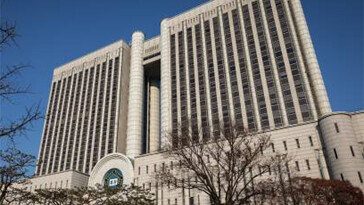
Founded in 794, Bongeunsa blossomed after being selected as the caretaker of the tomb of King Seongjong in 1498; its name means, literally, “To Receive the Grace of King Seongjong.” In 1550, Bongeun-sa became Korea’s central temple for Zen Buddhism.
Much of the temple was razed in a 1939 fire, a perennial peril for wood-built temples, with the result that the oldest building today is Panjeon, completed in 1855. Even so, the temple is home to a number of Buddhist cultural assets.
The 23-meter Grand Statue of the Maitreya Buddha is another treasure. The Maitreya, or Buddha of the Future, refers to the Bodhisattva who saves mankind. Construction of the statue began in 1986 to fulfill the will of the temple’s late abbot to build a statue yearning for national reunif-ication. The temple also remembers victims of the peninsula’s tragic modern history: It houses a shrine to the spirits of special operations troops lost in the Korean conflict.
Though the then-rural temple was engulfed by the expanding capital in the 1980s, life inside Bongeunsa is still lived in austere Buddhist style, marked by meditation, vegetarian meals and prayers. The public visit to pray, consult and take tea with the monks.
The principle behind temple meals is equality, boosting unity and harmony by sharing. Meals are a form of asceticism and are eaten in silence; even the sound of scraping bowls is frowned upon. Buddhism’s in-built environmental consciousness is seen in lack of wastage: Meals end with the cleansing of bowls with water.
There are many forms of meditation; Bongeunsa specializes in Zen. In this tradition, meditators concentrate upon a koan, or critical phrase (“hwadu” in Korean). Through this process, people may rid themselves of desire and achieve judgment and peace of mind.
For stressed-out G20 visitors who wish to transcend the summit and take at stab at achieving Nirvana, Bongeunsa is holding a special program, “Temple Life” from November 9-12. “The summit will be an excellent opportunity to spread the word on temple stays as world leaders will be coming,” said Kim Sang-ki, head of religious affairs at Bongeunsa.
By Min Byong-seon
bluedot@donga.com
-
- 좋아요
- 0개
-
- 슬퍼요
- 0개
-
- 화나요
- 0개
-
- 추천해요
- 개
지금 뜨는 뉴스
-

“카드로 코로나 예방” 배포한 의대교수 징역형 집유
- 좋아요 개
- 코멘트 개
-

‘1030 놀이터’ 틱톡도 韓 이커머스 상륙 준비
- 좋아요 개
- 코멘트 개
-
![[셀프건강진단]얼마 전부터 구강 안쪽이나 목에 혹이 만져진다](https://dimg.donga.com/a/464/260/95/1/wps/NEWS/FEED/Donga_Home_News/124673135.1.thumb.jpg)
댓글 0